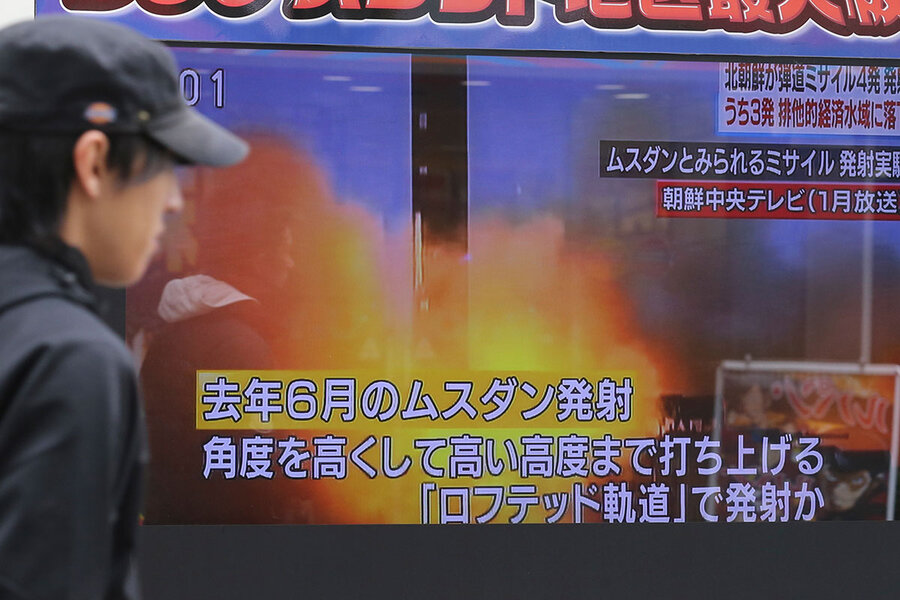Once more, North Korea launches banned ballistic missiles into Japanese waters
Loading...
Monday's successful launch by North Korea of four banned ballistic missiles, three of which landed in Japanese waters, has its neighbors and their allies concerned.
The missiles “clearly represent a new threat from North Korea,” said Japan’s Prime Minister Shinzo Abe during a parliamentary committee session that morning.
It appears the test launch was a response to annual United States-South Korean military drills that the two countries consider routine, but that the North views as a rehearsal for an invasion. In the past, North Korea has conducted missile launches to coincide with the joint military exercises, something it promised to do this year as well.
But Monday’s test launch comes as countries threatened by the hermit kingdom are reconsidering their stances towards it. The Trump administration is currently crafting its policy on North Korea, after The New York Times reported over the weekend that the US, starting with the Obama administration, hasn’t effectively developed cyber-weapons and electronic strikes to counter Pyongyang’s missile program. And Monday’s test launch has led some in Japan and South Korea to call for more robust defense spending, including on the US-made THAAD (Terminal High Altitude Area Defense) system that China vehemently opposes.
“This can be used by the government as a pretty credible reason why we have to spend more on defense at the expense of other budget items,” including social welfare programs, Narushige Michishita, director of the Security and International Studies Program at the National Graduate Institute for Policy Studies in Tokyo, told The New York Times.
The four missiles, fired simultaneously from a launch site near the border with China, landed in the sea off the northwest coast of Japan. Three of the missiles fell within the so-called exclusive economic zone, which extends 200 miles offshore, and where fishing and cargo ships are active. The fourth missile landed outside but close to the zone, according to Mr. Abe, Japan’s prime minister.
Officials and analysts doubt the missiles were intercontinental ballistic missiles (ICBMs), which can reach the United States. The missiles flew on average about 620 miles and reached a height of 160 miles. South Korea’s military said the missiles were unlikely to have been ICBMs. Joshua Pollack, editor of the US-based Non-Proliferation Review added that the launch “sounds like a field exercise involving deployed missiles, probably ones we’ve seen before.”
Days before the launch, North Korea threatened “strong retaliatory measures” in response to the US-South Korean military drills. Seoul and Washington consider the military drills defensive and routine. Technically, the Korean Peninsula remains in a state of war, since the Korean War ended in 1953 with an armistice, not a peace treaty.
But an unidentified spokeswoman for the North’s General Staff of the Korean People’s Army said Pyongyang’s reaction to the drills would be the toughest ever. In response to the drills last year, North Korea fired a long-range rocket that put an object into orbit.
But Monday’s launch also comes the month after North Korea test-fired a new type of missile into the sea, and has said it would continue to launch new strategic weapons. That launch was the first since President Trump took office. And it comes on the heels of the suspected assassination of the half-brother of North Korea's leader, which appears to be prompting a reassessment of China's relationship with the regime, as The Christian Science Monitor's Peter Ford reports.
... the assassination risks unleashing far-reaching strategic consequences: a new US-China campaign against the Supreme Leader’s illegal nuclear weapons program.
“The chances have never been bigger to coordinate” the two countries’ efforts to choke off Pyongyang’s nuclear work, says Zhu Feng, an influential Chinese policy adviser and professor at Nanjing University.
There are signs that Beijing is losing patience with North Korea, and inflicting real economic pain on its wayward ally for the first time. Now, as China at last wields an economic stick, the question is whether the new US administration is ready to offer diplomatic carrots to persuade Mr. Kim to freeze or abandon his nuclear ambitions.
North Korea’s threats have its neighbors worried. Japan plans to reinforce its ballistic missile defenses and is considering either buying THAAD or building a ground-based version of the Aegis system that is deployed on ships in the Sea of Japan. South Korean security officials also called for the early deployment of THAAD, according to The New York Times. China has protested the deployment of the anti-missile system on the Korean peninsula because the system’s radar would be able to track Chinese missile launches.
On Monday, Moscow also expressed concern over the North Korean launch.
"Definitely, we are seriously worried – these are the sort of actions that lead to a rise in tension in the region and of course in this situation, traditionally, Moscow calls for restraint from all sides," Kremlin spokesman Dmitry Peskov told a conference call with reporters.
But at a daily news briefing, China’s Foreign Ministry spokesman Geng Shuang encouraged prudence from both sides.
"All sides should exercise restraint and not do anything to irritate each other to worsen regional tensions," Mr. Geng said, referring to both the missile launch and U.S.-South Korean military exercises.
This report includes material from the Associated Press and Reuters.







